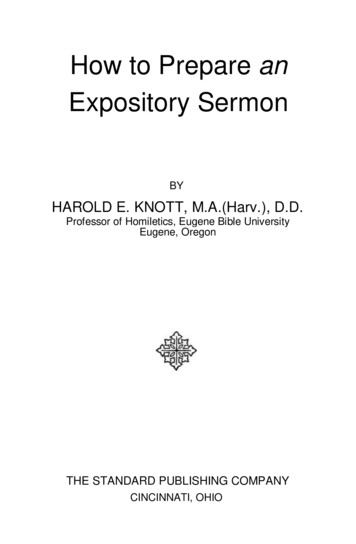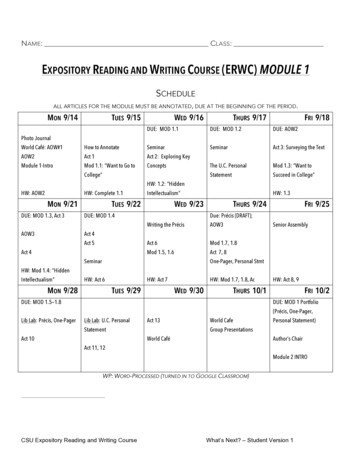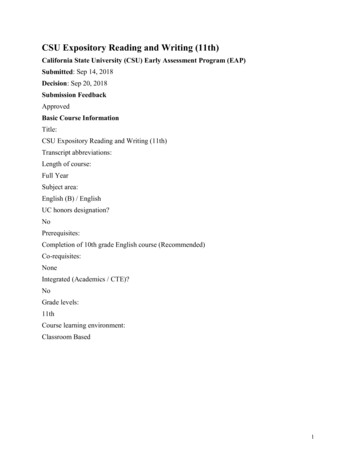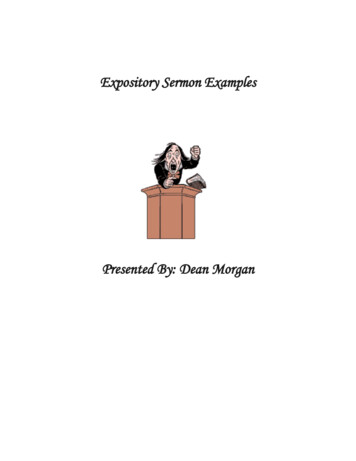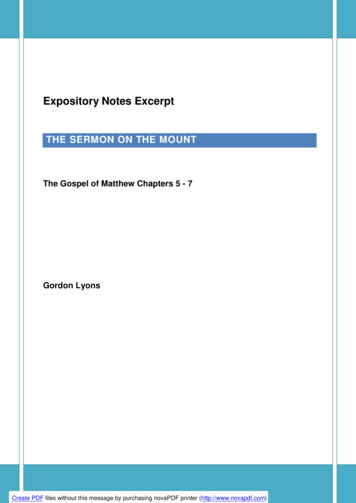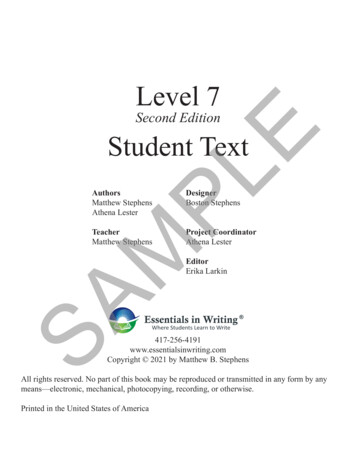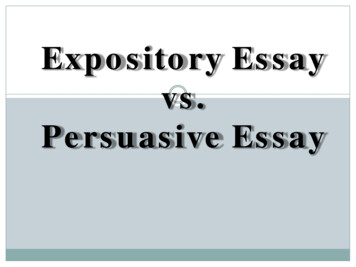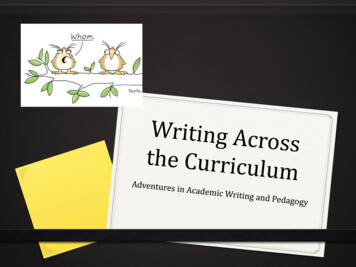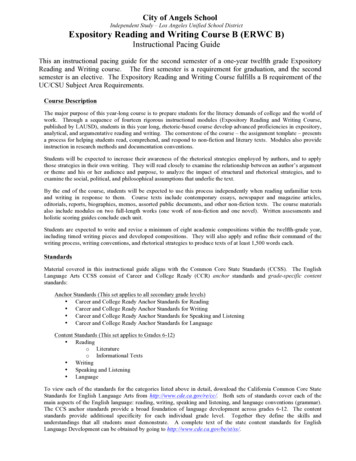
Transcription
City of Angels SchoolIndependent Study – Los Angeles Unified School DistrictExpository Reading and Writing Course B (ERWC B)Instructional Pacing GuideThis an instructional pacing guide for the second semester of a one-year twelfth grade ExpositoryReading and Writing course. The first semester is a requirement for graduation, and the secondsemester is an elective. The Expository Reading and Writing Course fulfills a B requirement of theUC/CSU Subject Area Requirements.Course DescriptionThe major purpose of this year-long course is to prepare students for the literacy demands of college and the world ofwork. Through a sequence of fourteen rigorous instructional modules (Expository Reading and Writing Course,published by LAUSD), students in this year long, rhetoric-based course develop advanced proficiencies in expository,analytical, and argumentative reading and writing. The cornerstone of the course – the assignment template – presentsa process for helping students read, comprehend, and respond to non-fiction and literary texts. Modules also provideinstruction in research methods and documentation conventions.Students will be expected to increase their awareness of the rhetorical strategies employed by authors, and to applythose strategies in their own writing. They will read closely to examine the relationship between an author’s argumentor theme and his or her audience and purpose, to analyze the impact of structural and rhetorical strategies, and toexamine the social, political, and philosophical assumptions that underlie the text.By the end of the course, students will be expected to use this process independently when reading unfamiliar textsand writing in response to them. Course texts include contemporary essays, newspaper and magazine articles,editorials, reports, biographies, memos, assorted public documents, and other non-fiction texts. The course materialsalso include modules on two full-length works (one work of non-fiction and one novel). Written assessments andholistic scoring guides conclude each unit.Students are expected to write and revise a minimum of eight academic compositions within the twelfth-grade year,including timed writing pieces and developed compositions. They will also apply and refine their command of thewriting process, writing conventions, and rhetorical strategies to produce texts of at least 1,500 words each.StandardsMaterial covered in this instructional guide aligns with the Common Core State Standards (CCSS). The EnglishLanguage Arts CCSS consist of Career and College Ready (CCR) anchor standards and grade-specific contentstandards:Anchor Standards (This set applies to all secondary grade levels) Career and College Ready Anchor Standards for Reading Career and College Ready Anchor Standards for Writing Career and College Ready Anchor Standards for Speaking and Listening Career and College Ready Anchor Standards for LanguageContent Standards (This set applies to Grades 6-12) Readingo Literatureo Informational Texts Writing Speaking and Listening LanguageTo view each of the standards for the categories listed above in detail, download the California Common Core StateStandards for English Language Arts from http://www.cde.ca.gov/re/cc/. Both sets of standards cover each of themain aspects of the English language: reading, writing, speaking and listening, and language conventions (grammar).The CCS anchor standards provide a broad foundation of language development across grades 6-12. The contentstandards provide additional specificity for each individual grade level. Together they define the skills andunderstandings that all students must demonstrate. A complete text of the state content standards for EnglishLanguage Development can be obtained by going to http://www.cde.ca.gov/be/st/ss/.
ERWC “B” INSTRUCTIONAL PACING GUIDECity of Angels, LAUSD Independent Study, Course ID# 230232Two Textbooks Are Required12th Grade Expository Reading and Writing Course,(CSU, LAUSD, 2008) ISBN: 978-0-9818314-1-1Expository Reading and Writing Course, Second Edition, Student Reader(CSU, 2013) ISBN: 978-0-9818314-6-6Two Novels Are RequiredStudent will select two novels to read during the course with the teacher’s prior approval. The first will bein the genre of Science Fiction: The Left Hand of Darkness by Ursula K. Le Guin, 1984 by GeorgeOrwell, Frankenstein by Mary Shelley, or Brave New World by Aldous Huxley.The second novel, or piece of literature, will be selected by the student with teacher’s approval. Otherselected sources of literature or reading may be, but are not limited to: poetry, prose, plays, novels, shortstories, essays, dramas, and other basic genres.Assignments and GradesWeekly assignments are worth 100 points.ActivitiesCompositions5050Student course work will be graded using the following breakdown:ABCDF90-100%80-89%70-79%60-69%0-59%All “D” or “F” quality workmust be revised to a “C.”Grading RubricThe grading Rubric is shown on page 16 if this Instructional Pacing Guide.Assignment FormatStudents must clearly label their work by the week number and the activity number. They are responsiblefor submitting all items marked with the square bullet shown below:q (ß )Final drafts should be typed and double-spaced, using Times New Roman 12 point font.Course Outline: ERWC Instructional Modules Semester TwoAssignment 1: Bring a Text to Class you like to ClassThis assignment sequence builds on texts that students bring in to chare and serves to introduce the second semester.Throughout this sequence, students will work on externalizing their existing textual skills and knowledge anddiscovering ways that they can bring their current reading expertise from outside of school to bear on texts in schoolthat they have never encountered before. An article on hip-hop music as a tool of resistance in youth cultures aroundthe world is also included as an example of the kind of follow-up text that teachers may use to complement the textsbrought in by students.Last Revised: 6-11-15 jthttp://www.lausd.net/city of angels/igs.htmlPage 2 of 16
ERWC “B” INSTRUCTIONAL PACING GUIDECity of Angels, LAUSD Independent Study, Course ID# 230232In addition, students will select two novels during the first week of the course to read for Assignments 3 and 8. A listof district approved novels should be used; and alternate, young adult, contemporary novels that are approved mayalso be used.Assignment 2: Language, Gender and CultureThe “Language, Gender and Culture” assignment invites students to explore how language use embodies culturalvalues and gender-based communication styles. This assignment draws on readings in sociolinguistics and literature.The students conclude the assignment by writing a text-based academic essay. The student will also continue readingtheir selected novel.Assignment 3: A Science Fiction Novel – The Left Hand of Darkness, 1984, Frankenstein, or BraveNew WorldThe Left Hand of Darkness is a classic, science fiction novel by Ursula K. Le Guin. Embedded in the literarynarrative are field reports, folk tales, and other genre-bending texts, which allow students to extend the analytical andpedagogical techniques of the assignment template to a full-length literary work. For the culminating task, studentswrite an extended argumentative essay.Three other reading options may be 1984 by George Orwell, Frankenstein by Mary Shelley, or Brave New World byAldous Huxley. The teacher may also substitute any other Science Fiction story.Assignment 4: The Politics of FoodThis assignment is based on two articles on the production and consumption of food. The articles were written overten years apart and have similar concerns: The health and well-being of humans. These two authors have differentways of pointing out the same issues, ultimately asking the students to consider the worlds of science, agriculture, andpolitics. Students conclude the assignment by writing a text-based academic essay on one of several possiblequestions.Assignment 5: Justice: Childhood Love LessonsThis assignment presents an argumentative essay by bell hooks about methods of childhood punishment and therelationships between discipline and expressions of love. Students are then asked to write a persuasive essay inresponse.Assignment 6: What’s Next? Thinking About Life After High School (from Module 1 in the CSU StudentReader)This assignment is based on several articles about the pros and cons of attending college after high school. Theseauthors present similar or opposing arguments why high school students should or should not consider attendingcollege, and discuss various other options for them. Students are asked to write a reflective essay in response; givingtheir opinion, and citing statements from the authors, to give a rationale for their response.Assignment 7: Bullying: A Research Project (from Module 12 in the CSU Student Reader)In this assignment, the student selects three articles with contrasting viewpoints in order to compare and contrast themagainst each other. The research articles are lengthy in nature and complex in academic vocabulary. Students areasked to examine and discuss the articles in reference to the bullying they have witnessed, experienced, orparticipated in – at their school or in their neighborhood. Students are asked to write a reflective response in whichthey address the issue of bullying.Assignment 8: A Selected Novel (or other work)The student has previously selected a novel to read with the teacher’s approval. The student will be asked to analyzethe impact of the author’s choices regarding how to develop and relate elements of a story or drama (e.g., where astory is set, how the action is ordered, how the characters/archetypes are introduced and developed). The student willalso produce a reflective essay where they quote, paraphrase and summarize the novel.Last Revised: 6-11-15 jthttp://www.lausd.net/city of angels/igs.htmlPage 3 of 16
ERWC “B” INSTRUCTIONAL PACING GUIDECity of Angels, LAUSD Independent Study, Course ID# 230232Career and College Readiness Anchor Standards for Reading (Grades 6-12)Key Ideas and Details: Read closely to determine what the text says explicitly and to make logical inferences from it; citespecific textual evidence when writing or speaking to support conclusions drawn from the text. Determine central ideas or themes of a text and analyze their development; summarize the keysupporting details and ideas. Analyze how and why individuals, events, or ideas develop and interact over the course of a text.Craft and Structure: Interpret words and phrases as they are used in a text, including determining technical, connotative,and figurative meanings, and analyze how specific word choices shape meaning or tone. Analyze the structure of texts, including how specific sentences, paragraphs, and larger portions of thetext (e.g., a section, chapter, scene, or stanza) relate to each other and the whole. Assess how point of view or purpose shapes the content and style of a text.Integration of Knowledge and Ideas: Integrate and evaluate content presented in diverse media and formats, including visually andquantitatively, as well as in words.1 Delineate and evaluate the argument and specific claims in a text, including the validity of thereasoning as well as the relevance and sufficiency of the evidence. Analyze how two or more texts address similar themes or topics in order to build knowledge or tocompare the approaches the authors take.Range of Reading and Level of Text Complexity: Read and comprehend complex literary and informational texts independently and proficiently.Career and College Readiness Anchor Standards for Writing (Grades 6-12)Text Types and Purposes: Write arguments to support claims in an analysis of substantive topics or texts using valid reasoningand relevant and sufficient evidence. Write informative/explanatory texts to examine and convey complex ideas and information clearly andaccurately through the effective selection, organization, and analysis of content. Write narratives to develop real or imagined experiences or events using effective technique, wellchosen details and well-structured event sequences.Production and Distribution of Writing: Produce clear and coherent writing in which the development, organization, and style are appropriateto task, purpose, and audience. Develop and strengthen writing as needed by planning, revising, editing, rewriting, or trying a newapproach. Use technology, including the Internet, to produce and publish writing and to interact and collaboratewith others.Research to Build and Present Knowledge: Conduct short as well as more sustained research projects based on focused questions, demonstratingunderstanding of the subject under investigation. Gather relevant information from multiple print and digital sources, assess the credibility and accuracyof each source, and integrate the information while avoiding plagiarism. Draw evidence from literary or informational texts to support analysis, reflection, and research.Range of Writing: Write routinely over extended time frames (time for research, reflection, and revision) and shorter timeframes (a single sitting or a day or two) for a range of tasks, purposes, and audiences.To view the Career and College Readiness Standards for Language, Speaking and Listening, as well as grade-specificcontent standards, go to http://www.cde.ca.gov/re/cc/.Last Revised: 6-11-15 jthttp://www.lausd.net/city of angels/igs.htmlPage 4 of 16
ERWC “B” INSTRUCTIONAL PACING GUIDECity of Angels, LAUSD Independent Study, Course ID# 230232Assignments for Week 1: Bring a Text You Like to Class (Module 9)DAY 1: Activities 1, 5, 6 and 8: Prereading1. Activity 1: Challenge Your Teacher to a Reading Match! Bring a text to class that you know you can readexpertly (page 21 of Module 9).q Bring a copy of your text to class to read to your teacher that you feel you can read expertly but thatyou think your teacher or other people you know might have difficulty understanding.q If you don’t have an idea for a text to bring to class, then you may use the article, “Hip-HopBecoming a Worldwide Language for Youth Resistance” inside your textbook on page 19.2. Activity 5: Surveying the Text: Complete Activity 5 on page 26.q Write down and answer questions 1 through 8 on page 26. All your answers throughout this entirecourse must be composed in fully complete sentences, with appropriate punctuation.3. Activity 6: Introducing Key Vocabulary: Complete Activity 6 on page 27.q Write down and answer questions 1 through 6 on page 27.4. Activity 8: Getting Ready to Read: Complete Activity 8 on page 27.q Spend a few minutes writing about your personal expertise as a reader. In your freewrite, answertwo out of the four questions asked in Activity 8.5. Select the science fiction novel you will read for Assignment 3: Look on page 3 of your InstructionalPacing Guide for the science fiction choices.q Confirm your selection with your teacher.q Begin reading 25 pages each and every day.DAY 2: Activities 9, 10 and 11: Prereading and Reading1. Activity 9: Making Predictions and Asking Questions: Complete Activity 9 on page 28.q Instead of discussing with your classmates, write down your responses to questions 1 through 8 inActivity 9 on page 28.2. Activity 10: Looking Closely at Language: Complete Option 2 on page 29.q Formulate two questions based on your text that will generate an interesting discussion.3. Activity 11: Analyzing Stylistic Choices: Complete Activity 11 on pages 29 and 30.q Look up the words, “denotative” and “connotative.” You will need to know what those wordsmean before you answer the next questions.q After reading the text you chose, write down and answer questions 1 through 5 on page 29. Seebelow before you begin. (You need to use the definitions on page 30 to help yourself.)q Use the definitions on page 30 to help you with your written responses to questions 1 through 5 onpage 29.DAY 3: Activities 13 and 14: Postreading1. Activity 13: Thinking Critically: Complete Activity 13 on page 31.q Write down and answer questions 1 through 3 on page 31.2. Activity 14: Thinking Metacognitively About Reading: Complete Activity 14 on page 31.q Write a paragraph or two describing your personal experience with the text you chose. There areten sentence starters that will help you to begin to shape your ideas. They are bulleted.q Use at least two of the sentence starters in your paragraph(s).DAY 4: Select A Novel to Read for Assignment 81. Activity for the day: Select a novel to read for your final assignment.q Your teacher will have a list of great literature that you may choose from. Or, you may go to thePublic Library and select a well-known novel with the help of the librarian. Your novel may be byan American author or a foreign author.q Once you have selected a novel, you must read 10 to 20 pages of it daily during the course.q Take notes on what you are reading every day. You will need those notes as you write yoursummary of the novel during the final assignment (Assignment 8).Last Revised: 6-11-15 jthttp://www.lausd.net/city of angels/igs.htmlPage 5 of 16
ERWC “B” INSTRUCTIONAL PACING GUIDECity of Angels, LAUSD Independent Study, Course ID# 230232DAY 5: Edit and Correct All Your Work.q q q q Reread all of your answers. Correct any misspelled words, and add punctuation where you mayhave forgotten it.Ask yourself if you can read what you wrote. If you can’t read it, then neither can your teacher.Make your writing legible, neat, and easy to read.Once you have corrected your work, ask someone else to read it and check it for errors. It willimprove your grade if the work you turn in is your best effort.Final drafts should be typed and double-spaced, using Times New Roman 12 point font.Assignments for Week 2: Language, Gender, and Culture (Module 10)DAY 1: Activities 2, 3, 4 and 17: Prereading1. Activity 2: Getting Ready to Read: Complete Activity 2 on page 46 (of Module 10).q Choose one of the four quickwrite topics in Activity 2, and write your response to the prompt and itsquestions. Your response must be a least one, fully complete paragraph.2. Activity 3: Introducing Key Vocabulary: Complete Activity 3 on page 47.q Do a search of the term, “communication.” Find out what its origin and history are.q Create a chart like the one on page 47. On the left side, list at least five effective means ofcommunication. On the right side, make a list of at least five ineffective means of communication.3. Activity 4: Making Predictions and Asking Questions: Complete Activity 4 on page 47. Instead ofdiscussing the questions, you will write down your response to each question or writing prompt.q Write down the questions and answer them.q Share your predictions.4. Activity 17: Getting Ready to Read: Complete Activity 17 on page 54.q Write down the question and answer it.5. If you haven’t already done so, select the novels you will read for Assignments 3 and 8: Look on page 3 ofyour Instructional Pacing Guide for the science fiction choices.q Confirm your selections with your teacher.q Begin reading 25 pages each day.DAY 2: Activities 5, 6, 7, 8; and 18 and 19: Reading1. Activity 5: First Reading: Complete Activity 5 on page 48.q Look for Tannen’s thesis as you read; and write down what you think it is.2. Activity 6: Looking Closely at Language: Complete Activity 6 on page 48.q On two separate sheets of paper, draw a tree with a trunk and several branches.q Label the first page/tree, “Indirect Communication.”q Label the second page/tree, “Direct Communication.”q Look at the chart you made yesterday of effective and ineffective communication. Select the wordsyou feel match the tree that you labeled, “Indirect Communication.” Put them on the branches.q Select the words you feel match the tree that you labeled, “Direct Communication.” Put them onthe branches.q Follow all the directions in Activity 6 and answer all the questions you are asked.3. Activity 7: Rereading the Text: Complete Activity 7 on page 48.q Write down and answer questions 1 and 2 only.4. Activity 8: Considering the Structure of the Text: Complete Activity 8.q Briefly write an outline of Tannen’s text.q Analyze why Tannen devotes the majority of her article to analyzing women’s speech.q Answer the question, “Does this rhetorical choice strengthen or undermine the persuasiveness ofher argument?”5. Activity 18: Looking Closely at Language: Complete Activity 18 on page 54.q Write down and answer questions 2 and 3 only.6. Activity 19: First Reading: Complete Activity 5 on page 48.q Look for Ehrlich’s main point that she seems to be making while you read; and write it down.Last Revised: 6-11-15 jthttp://www.lausd.net/city of angels/igs.htmlPage 6 of 16
ERWC “B” INSTRUCTIONAL PACING GUIDECity of Angels, LAUSD Independent Study, Course ID# 230232DAY 3: Activities 9 and 21: Postreading1. Activity 9: Postreading: Complete Activity 9 on page 49.q In activity 9, summarize and write a written response to part “2C” only. Make sure you haveanswered all of the questions within 2C.2. Activity 21: Summarizing and Responding: Complete Activity 21 on page 55.q In Activity 21, summarize and write a written response to questions 1 and 2 only. Make sure youhave answered all the questions within the writing prompts for 1 and 2.DAY 4: Activities 22, 25 and 26: Prewriting, Writing, and Revising and Editing1. Activity 22: Prewriting: Complete Activity 22 on pages 55 and 56.q Write down and answer the four bulleted questions so you are prepared to begin a first draft.q Carefully read the writing assignment.2. Activity 25: Organizing the Essay and Developing the Content: Complete Activity 25 on pages 56 and 57.q Write your first draft following the directions for the Introduction, Body and Conclusion describedin Activity 25.q Leave your work alone for at least two hours before you begin your revision, so you are refreshed.3. Activity 26: Revising the Draft: Complete Activity 26 on page 57.q Under “Revising the Draft,” only do the “Individual Work.”q Make sure you have addressed all 10 questions as you work on your revision.DAY 5: Activity 28: Editing the Draft1. Activity 28: Editing the Draft: Complete Activity 28 on page 58.q Use all the guidelines under, “Editing Guidelines for Individual Work” to help you.q Final drafts should be typed and double-spaced, using Times New Roman 12 point font.Assignments for Week 3: Science Fiction Novels: The Left Hand of Darkness,1984, Frankenstein, or Brave New World (Module 11)DAY 1: Activities 1, 3 and 12: Prereading1. Activity 1: An Overview of the Book: If you have selected, The Left Hand of Darkness to read, thencomplete Activity 1 on pages 61 and 62 (of Module 11).q If you have selected the novel, 1984 by George Orwell, then go to the following webpage for anoverview of the book: http://www.sparknotes.com/lit/1984/summary.htmlq If you have selected the novel, Frankenstein by Mary Shelley, then go to the following webpagefor an overview of the book: .htmlq If you have selected the novel, Brave New World by Aldous Huxley, then go to the followingwebpage for an overview of the book: l2. Activity 3: Getting Ready to Read: Complete Activity 3 on page 64. This applies to any of the novels.q Write down and answer questions 1 through 5 on page 64.3. Activity 12: Making Predictions and Asking Questions: If you have selected, The Left Hand of Darknessto read, then complete Activity 12 on pages 70 through 72.q Select one of the three perspectives as a focus of reading (psychologist, anthropologist, or politicalofficer).q Select five bulleted questions to answer underneath one of the perspectives.q Write down the questions and answer them.4. Activity 12: Making Predictions and Asking Questions: If you have selected 1984, Frankenstein, orBrave New World to read, then complete Activity 12 on page 70.q Read the first paragraph under the heading, and answer the question, “What is this novel about?”q Write one paragraph about how the novelist is exploring some particular theme or idea(s).q Make a prediction about what you think will happen in the novel.Last Revised: 6-11-15 jthttp://www.lausd.net/city of angels/igs.htmlPage 7 of 16
ERWC “B” INSTRUCTIONAL PACING GUIDECity of Angels, LAUSD Independent Study, Course ID# 230232DAY 2: Reading1. Finish reading the novel so you will be able to complete the writing assignments.q Make a short outline of the events, characters, and plot in each chapter.q Use your notes so you can refer to them when you begin to write.DAY 3: Activity 21: Prewriting1. Activity 21: Getting Ready to Write: Complete Activity 21 on page 84.q If you read The Left Hand of Darkness, answer the question, “Is your opinion leaning towardsjoining the Ekumen, or not?” Explain why in two paragraphs.q If you read 1984, Frankenstein, or Brave New World, then create a significant question based onyour opinion of the book’s particular theme or idea(s). Write down your question and answer it intwo paragraphs.q Make sure to jot down some quotes or statements made by one of the main characters that willsupport your opinion and the thesis of your paper.DAY 4: Activities 23, 24 and 25: Writing, Revising and Editing1. Activity 23: Composing a Draft: Complete Activity 23 on page 86.2. Activity 24: Organizing the Essay and Developing the Content: Complete Activity 24 on page 86.q Respond to the bulleted questions 1, 3, 4 and 5 under the heading, Introduction.q Respond to all the bulleted questions under the headings, Body and Conclusion.3. Activity 25: Revising the Draft: Complete Activity 25 on page 87.q Have a friend, family member, or adult read your draft.q Ask them the four bulleted questions.q Make improvements based on their feedback.DAY 5: Activity 26: Editing the Draft1. Activity 26: Editing the Draft: Complete Activity 26 on page 87.q Use the Guidelines for Individual Work.q Final drafts should be typed and double-spaced, using Times New Roman 12 point font.Assignments for Week 4: The Politics of Food (Module 12)DAY 1: Activities 1, 3, 4 and 5: Prereading1. Activity 1: Getting Ready to Read: Complete Activity 1 on page 47 (of Module 12).q Select one of the four quickwrites. Write down the prompt and write a response to it.2. Activity 3: Surveying the Text: Complete Activity 3 on page 48.q Respond to the two writing prompts in fully complete sentences.3. Activity 4: Making Predictions and Asking Questions: Complete Activity 4 on pages 48 and 49.q Write down the eight bulleted questions and answer each one thoughtfully.4. Activity 5: Introducing Key Vocabulary: Complete Activity 5 on page 49.q Look up each vocabulary word and make a chart of them. Using fully complete sentences, useeach word correctly in a sentence.q Create an advertisement for a food product from the “Additional Activity.”DAY 2: Activities 6, 8, 9 and 11: Reading and Postreading1. Activity 6: First Reading: Complete Activity 6 on page 62.q Write down the six bulleted questions and answer them.2. Activity 8: Analyzing Stylistic Choices: Complete Activity 8 on pages 51 through 53.q Answer all of the questions in sections 1 and 2.3. Activity 9: Considering the Structure of the Text: Complete Activity 9 on page 53 and 54.q In sections 1 and 2, do the activities called, “Mapping the Content’ and “Descriptive Outlining” forboth sections.4. Activity 11: Thinking Critically: Complete Activity 11 on pages 54 and 55.q Write down and answer all bulleted questions.Last Revised: 6-11-15 jthttp://www.lausd.net/city of angels/igs.htmlPage 8 of 16
ERWC “B” INSTRUCTIONAL PACING GUIDECity of Angels, LAUSD Independent Study, Course ID# 230232DAY 3: Activities 12, 13, 15 and 16: Using the Words of Others, and Prewriting1. Activity 12: Using the Words of Others: Complete Activity 12 on pages 55 and 56.q Choose three passages from the text you are reading that you might be able to use in an essay.2. Activity 13: Reading the Assignment: Complete Activity 13 on page 57.q Select a topic from one of the five that are shown.q Read the “Strategies for Reading Assignments.”3. Activity 15: Getting Ready to Write: Complete Activity 15 on page 59.q Use one or more of the “Strategies for Reading Assignments” shown in bullets on page 57.4. Activity 16: Formulating a Working Thesis: Complete Activity 16 on page 59.q Analyze the four bulleted questions.q Draft your possible thesis.DAY 4: Activities 17, 18 and 19: Writing1. Activity 17: Composing a Draft: Read and complete Activity 17 on pages 60 and 61.2. Activity 18: Organizing the Essay: Read and complete Activity 18 on pages 62 and 63.3. Activity 19: Developing the Content: Read and complete Activity 19 on page 63.DAY 5: Activities 20, 21 and 22: Revising and Editing1. Activity 20: Revising the Draft: Complete the “Individual Work” on pages 63 and 64.q Consider questions 1 through 3 as you revise your work.2. Activity 21: Editing the Draft: Read and complete Activity 21 on page 64.3. Activity 22: Reflecting on the Writing: Complete Activity 22 on page 65.q Write down and answer questions 1 through 6 on page 65.q Final drafts should be typed and double-spaced, using Times New Roman 12 point font.Assignments for Week 5: Justice: Childhood Love Lessons (Module 13)DAY 1: Activities 1-5: Prereading1. Activity 1: Getting Ready to Read: Complete Activity 1 on page 35 (of Module 13).q Write down the quickwrite and respond to it in fully complete sentences.2. Activity 2: Surveying the Text: Complete Activity 2 on page 35 and 36.q Respond to the first three bulleted questions and tasks.3. Activity 3: Making Predictions and Asking Questions: Complete Activity 3 on page 36.q Write down the bulleted questions and write your responses to them.4. Activity 4: Introducing Key Concep
This an instructional pacing guide for the second semester of a one-year twelfth grade Expository Reading and Writing course. The first semester is a requirement for graduation, and the second semester is an elective. The Expository Reading and Writing Course fulfills a B requirement of the UC/CSU Subject Area Requirements. Course Description
